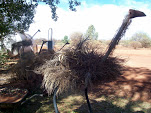I recently presented a paper at the 2009 State of Australian Cities (SOAC) Conference in Perth, Western Australia. The presentation was focusing on the quantitative component of my research. The data is still fairly raw at this stage and warrants further analysis. However I thought I'd provide a few statistics for you to ponder upon.
The title of my paper is "Art will save the city": The arts and city vitality, growth, and sustainability. This was inspired by an article by Matarasso in 2000 in which he states that culture is "perhaps the only thing which can save the city" (p1). As I've already mentioned in this blog, and I'm sure many already know, the arts, culture, and creativity have been applauded for their role in the attraction and retention of Florida's 'creative class' and all that this subsequently implies, for their role in the gentrification and revitalisation of neighbourhoods, in establishing, strengthening or reinventing identity and sense of place, building social cohesion, resilience, and wellbeing, etc., etc. The arts also allow us to explore social constructs and the lived experience of place, space, and identity for the residents involved.
This presents a dilemma for regional and rural residents. They often have limited access and opportunity to experience or engage in the arts. There are few statistics on the nature and level of arts activity in regional Western Australia, and research is often limited and narrow in scope.
So one of my aims was to determine the level and nature of artistic activity in regional WA, so here are some of the statitsics...
As expected, the majority of the respondents were female (59%), with 30% male and 11% did not specify their gender. The age range was 13 to 90 years old with an average of 53 years. Overall they were a pretty active bunch with 96% actively engaging in non-arts activities, such as volunteering, sport, gardening, etc. and 87% attended other non-arts related events.
The greatest level of arts engagement was through reading literature, ie novels, poetry and plays of which 76% of the sample engaged in. This was followed by attendance at a gallery, an arts or craft festival, or other places for their design or hertiage value (69%). Almost two thirds (62%) activiely participated in some art form, including creative writing, playing music, dance, or visual arts and 35.5% had attended a performing arts event in the past 12 months.
All of the sample (n=948) engagaed in the arts by listening, watching, or reading it in the media or on the internet. Which would suggest to me that perhaps the attendance figures cited above would be higher if regional and rural audiences had greater access and opportunities to experience the arts.
The common responses for why they attended arts events was as a social opportunity, for entertainment value, and to show their support to the community, the artists and the organisers. One respondent even stated that "we need these kinds of shows to cope with life these days".
.JPG)
Overall I think the levels of arts activity in regional Autralia is quite high. There is definitely patterns and trends starting to emerge from the data which is encouraging as I delve further into the final year of my PhD.




No comments:
Post a Comment